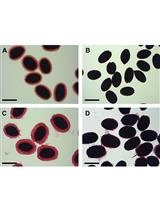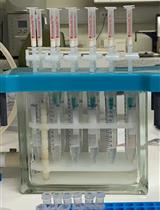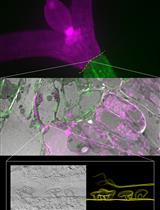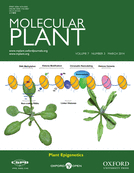- Submit a Protocol
- Receive Our Alerts
- Log in
- /
- Sign up
- My Bio Page
- Edit My Profile
- Change Password
- Log Out
- EN
- EN - English
- CN - 中文
- Protocols
- Articles and Issues
- For Authors
- About
- Become a Reviewer
- EN - English
- CN - 中文
- Home
- Protocols
- Articles and Issues
- For Authors
- About
- Become a Reviewer
Endogenous ABA Extraction and Measurement from Arabidopsis Leaves
Published: Vol 4, Iss 19, Oct 5, 2014 DOI: 10.21769/BioProtoc.1257 Views: 12767
Reviewed by: Arsalan DaudiTie LiuAnonymous reviewer(s)

Protocol Collections
Comprehensive collections of detailed, peer-reviewed protocols focusing on specific topics
Related protocols

Analysis of Monosaccharides from Arabidopsis Seed Mucilage and Whole Seeds Using HPAEC-PAD
Gillian H. Dean [...] George W. Haughn
Dec 20, 2019 5692 Views

Extraction and Quantification of Plant Hormones and RNA from Pea Axillary Buds
Da Cao [...] Christine A. Beveridge
Oct 5, 2022 2869 Views

Targeting Ultrastructural Events at the Graft Interface of Arabidopsis thaliana by A Correlative Light Electron Microscopy Approach
Clément Chambaud [...] Lysiane Brocard
Jan 20, 2023 2923 Views
Abstract
The endogenous messenger, the phytohormone abscisic acid (ABA) plays a major role in plant’s adaption to drought, salinity, cold and other abiotic stresses. In addition to abiotic stress signaling, ABA is involved also in developmental regulation and in responses to diverse biotic stresses. Dehydration stress results in a strong increase in endogenous ABA levels, which can be perceived by RCAR/PYR1/PYL receptors, initiating the ABA signaling pathway to coordinate the genome-wide gene expression, and plants adaptive physiological responses. ABA biosynthesis triggered by environmental cues as well as developmental signals occurs predominantly in vascular parenchyma cells. The measurement of ABA content in different organ/tissues is required to understandings how ABA is produced and delivered within the plants upon various stress conditions and to elucidate its regulatory role in both physiological and transcriptional responses.
Quantitation of ABA can be achieved by two approaches: 1) the use of gas chromatography–tandem mass spectrometry (GC-MS) and 2) the use of immunoassays. Both methods are sensitive to trace amount of ABA down to the low pico-gram (10-12 g/ml FW) range. The GC-MS method needs special facilities, however the antibody based method is relatively simple and can be carried out in laboratory. Here we describe an easy method for ABA extraction from Arabidopsis seedlings, and further determination of ABA levels by competitive ELISA kit.
Materials and Reagents
- 3-week old Arabidopsis thaliana (A. thaliana) plants.
- Methanol (Thermo Fisher Scientific, Acros Organics, catalog number: AC124790010 )
- Sterile deionized H2O
- Sodium diethyldithiocarbamate trihydrate (Sigma-Aldrich, catalog number: D3506 )
- Trizma® base (Sigma-Aldrich, catalog number: T1503 )
- Magnesium chloride (Sigma-Aldrich, catalog number: M8266 )
- Sodium chloride (Sigma-Aldrich, catalog number: S3104 )
- Phytodtek ELISA kit (Agdia, catalog number: PDK 09347 )
- Extraction buffer (see Recipes)
- Methanolic Tris buffer (see Recipes)
Equipment
- Microcentrifuge (Eppendorf, model: 5415R )
- Tweezers or forceps
- Mortar and pestle
- Siliconized borosilicate tube (VWR International, catalog number: EPCTS-13100 )
- Liquid nitrogen
- pH meter (Corning, catalog number: 443i )
- Refrigerator 4 °C
- Refrigerated CentriVap Benchtop Vacuum Concentrator (Labconco, catalog: 7310020 )
- Vertical light path photometer for microtiter plate (Dynex Semiconductor, MRX revelation microplate reader)
Procedure
- Arabidopsis seedlings were grown in potting soil under regular growth conditions (at 22 °C with a 12-h light photoperiod and light intensity of 180 μmol/m2/s) until rosettes were fully expanded (~4 cm diameter).
- Collect ~15 rosette leaves (~200 mg) from ~3 week old Arabidopsis seedlings with sharp tweezers, and measure the fresh weight (FW).
- Freeze leaf tissues with liquid nitrogen immediately.
- Carefully grind them in a mortar and pestle to get the fine powder.
- Add 500 µl extraction buffer to mix them thoroughly by gently pipetting.
- Transfer extracts to a covered, siliconized borosilicate tube.
- Incubate the extracts overnight in darkness at 4 °C.
- Centrifuge at 8, 000 x g for 10 min at 4 °C.
- Transfer supernatant to pre-cold new 1.5 ml Eppendorf tube.
- Vacuum centrifuge at 4 °C to evaporate the supernatant.
- Dissolve the residue with 500 µl methanolic Tris buffer (if necessary, gently pipette up and down a few times).
- Measure the ABA content with Phytodtek ELISA kit according the manufacturer’s instructions.
Notes
- In our procedure, the extractions tube should always be kept on ice during steps 5-11, and a lightproof cover is recommended to prevent extracts from degradation.
- In addition to Arabidopsis leaf, other tissues like root, flower, seed, etc., can be used for extraction. Depending on the type of tissues, sufficient material should be collected until ~200 mg of fresh weight.
Recipes
- Extraction buffer
90% (v/v) methanol
200 mg/L sodium diethyldithiocarbamate trihydrate
- Methanolic tris buffer
10% methanol
50 mM Tris (pH 8.0)
1 mM MgCl2
150 mM NaCl
Acknowledgments
This work was supported by NSF award MCB-1121898 to Z.A. and M.F. The authors thank Dr. Laetitia Virlouvet (University of Nebraska-Lincoln) for technical assistance and valuable discussions.
References
- Ding, Y., Avramova, Z. and Fromm, M. (2011). The Arabidopsis trithorax-like factor ATX1 functions in dehydration stress responses via ABA-dependent and ABA-independent pathways. Plant J 66 (5): 735-744.
Article Information
Copyright
© 2014 The Authors; exclusive licensee Bio-protocol LLC.
How to cite
Liu, N., Ding, Y., Fromm, M. and Avramova, Z. (2014). Endogenous ABA Extraction and Measurement from Arabidopsis Leaves. Bio-protocol 4(19): e1257. DOI: 10.21769/BioProtoc.1257.
Category
Plant Science > Plant biochemistry > Plant hormone
Plant Science > Plant physiology > Tissue analysis
Do you have any questions about this protocol?
Post your question to gather feedback from the community. We will also invite the authors of this article to respond.
Share
Bluesky
X
Copy link










